Ammonia
CASRN 7664-41-7 | DTXSID0023872
IRIS Toxicological Review of Ammonia Noncancer Inhalation (Final Report)
On this page:
Overview
EPA has finalized the Integrated Risk Information System (IRIS) Assessment of Ammonia (Noncancer Inhalation). This assessment addresses the potential noncancer human health effects from long-term inhalation exposure to ammonia. Now final, this assessment will update the current toxicological information on ammonia posted in 1991. EPA’s program and regional offices may use this assessment to inform decisions to protect human health.Background
Ammonia occurs naturally in air, soil, and water. Ammonia is also produced by humans and other animals as part of normal biological processes. Ammonia is used as an agricultural fertilizer and in many cleaning products. Exposure to ammonia occurs primarily through breathing air containing ammonia gas, and may also occur via diet, drinking water, or direct skin contact. Concentrations of ammonia measured in ambient outdoor air range from 0.28‒15 μg/m3 and in indoor air from 0.09–166 μg/m3.Health effects of inhaled ammonia observed at levels exceeding naturally-occurring concentrations are generally limited to the respiratory tract, the site of direct contact with ammonia. Short-term inhalation exposure to high levels of ammonia in humans can cause irritation and serious burns in the mouth, lungs, and eyes. Chronic exposure to airborne ammonia can increase the risk of respiratory irritation, cough, wheezing, tightness in the chest, and reduction in the normal function of the lung in humans. Studies in experimental animals similarly indicate that breathing ammonia at sufficiently high concentrations can result in effects on the respiratory system. Animal studies also suggest that exposure to high levels of ammonia in air may adversely affect other organs, such as the liver, kidney, and spleen.
| Date | Description |
|---|---|
| May 1991 | The RfC for ammonia was posted to the IRIS database. |
| Feb 2012 | Revised draft assessment was submitted for Agency review and interagency science consultation. |
| Jun 2012 | EPA released the external review draft of the ammonia assessment for public review and comment. Additionally, the interagency science consultation draft, comments from reviewers, and EPA's responses to selected major interagency comments were also released. [Federal Register Notice Jun 8, 2012] |
| Jul 2012 | EPA conducts public listening session on the draft assessment. |
| Aug 2013 | EPA's Science Advisory Board (SAB) announced a request for nominations for experts to augment the SAB Chemical Assessment Advisory Committee (CAAC) for the review of the EPA's draft IRIS assessment for ammonia [Federal Register Notice Aug 28, 2013] (3pp., 210Kb, about PDF), and made available the revised external review draft assessment and draft charge to peer reviewers. |
| Jul 2014 | EPA's SAB CAAC convenes to discuss the external review draft of the IRIS assessment. |
| Aug 2015 | EPA's IRIS Program receives final external peer review report from the SAB. To address SAB recommendations related to the assessment of ingested ammonia and to allow completion of the assessment of inhaled ammonia, the scope of the assessment was limited to the noncancer effects of ammonia via inhalation exposure. An assessment of ammonia (oral) was added to the IRIS Multi-Year Agenda in 2015. |
| Jun 2016 | EPA submits the revised draft for final Agency Review and Interagency Science Discussion. |
| Sep 2016 | EPA posted the final IRIS Toxicological Review of Ammonia (noncancer Inhalation) to the IRIS database. |
Download(s)
This document has been reviewed in accordance with U.S. Environmental Protection Agency policy and approved for publication. Mention of trade names or commercial products does not constitute endorsement or recommendation for use.
- IRIS Executive Summary of Ammonia -- Noncancer Inhalation (PDF) (10 pp, 320.3 KB, about PDF)
- IRIS Toxicological Review of Ammonia -- Noncancer Inhalation (Final Report) (PDF) (99 pp, 1.3 MB, about PDF)
- IRIS Toxicological Review of Ammonia -- Noncancer Inhalation (Final Report) -- Supplemental Information (PDF) (139 pp, 1.6 MB, about PDF)
If you have a disability and the format of any material on our web pages interferes with your ability to access the information, please reach out to us using the Contact Us about IRIS form for assistance. To enable us to respond in a manner most helpful to you, please indicate the nature of the accessibility problem, the web address of the requested material, your preferred format in which you want to receive the material (electronic format (ASCII, etc.), standard print, large print, etc.), and your contact information.
Document Related Link(s)
- IRIS Toxicological Review of Ammonia (External Review Draft)
- IRIS Toxicological Review of Ammonia (Interagency Science Consultation Draft)
- IRIS Toxicological Review of Ammonia (Revised External Review Draft)
- IRIS Toxicological Review of Ammonia Noncancer Inhalation (Interagency Science Discussion Draft)
Related Links
Critical Effect Systems
Chemical Structure for
Ammonia

Synonyms
- Am-Fol
- Ammonia
- Ammonia
- Ammonia gas
- Ammonia solution, strong
- Ammoniac [French]
- Ammoniaca [Italian]
- Ammoniak [German]
- Amoniaco [Spanish]
- Amoniak [Polish]
- Anhydrous ammonia
- Aromatic ammonia, vaporole
- Caswell No. 041
- EPA Pesticide Chemical Code 005302
- HSDB 162
- Nitro-sil
- R 717
- Spirit of Hartshorn
- UN 1005
- UN 2073
- UN 2672
- 7664-41-7

